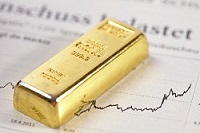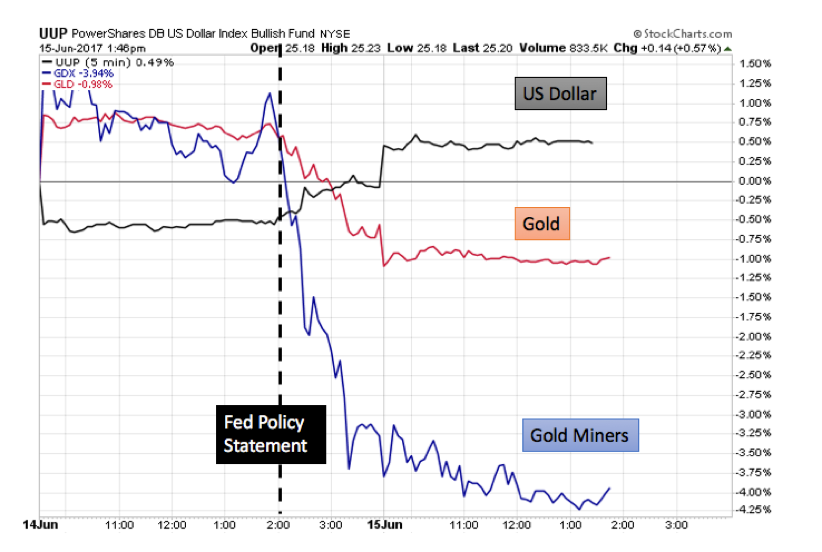Gold Price Forecast – Caution Advised After Fed Meeting

On the heels of the Federal Reserve’s most recent ¼ point interest rate hike on Wednesday, gold and the precious metals complex have seen a negative bearish reversal that deserves caution over the short and intermediate term.
Fundamentally, the interest rate hike and accompanying policy statement, which indicated that the Fed would begin to taper down its balance sheet over the coming year, was interpreted by the market as supportive for the US dollar and negative for gold. As precious metals investors, we know that the Fed has already printed nearly $4 trillion dollar of fresh liquidity in support of the financial system over the past decade, and that the feasibility of the central bank reducing this liquidity by any significant amount is doubtful. Yet what is important over the short run is not so much our fundamental beliefs – but rather how the market itself is reacting.
For example, those who ignored the actual response of the gold market in 2011 suffered severe losses as the precious metals declined through late 2015. All the while, the Fed continued to print money. The market can move contrary to perceived fundamentals for many years. Caution is again advised at this juncture.
Fed To Normalize Balance Sheet
The key statement from the Fed meeting on Wednesday was: “The Committee currently expects to begin implementing a balance sheet normalization program this year, provided that the economy evolves broadly as anticipated. This program… would gradually reduce the Federal Reserve's securities holdings by decreasing reinvestment of principal payments from those securities.”
Let us examine the price action for the US dollar, gold, and the gold miners in the wake of the Fed policy decision on Wednesday:
The US dollar, which had been trending lower for the last three months, showed a sharp reversal higher immediately after the Fed statement. Gold sold off with an outside bearish reversal, and the gold miners fell a multiple of the gold price.
Clearly, the market is taking the Fed at its word, and believes that the coming reduction in the Fed’s balance sheet will benefit the US dollar. Gold tends to move opposite to the dollar over the short and intermediate timeframe.
Gold’s Primary Pattern
Switching over to examine the gold market itself, we must place the move this week into proper context:
Gold has remained range-bound for the past year, attempting to break higher out of a pennant-shaped consolidation, as shown above. Last week gold broke above this downward sloping resistance (magenta color) for a brief trading day, but then failed to hold the advance. This constitutes a false-breakout in our technical model.
Note that gold failed just underneath the $1,300 region, which was resistance that had formed on the heels of the Trump victory last November 9. That day saw the highest daily volume of gold contracts traded in futures history – so there are plenty of holders who are still underwater from that price level. Such a high volume reversal last November largely explains why gold has been unable to break above $1,300 thus far in 2017.
Short-term support now comes in at the rising (dashed) trendline, near $1,230. If that were to break, the next support we are watching comes in at the rising 2015 – 2017 trendline (blue), at $1,150. A break of $1,150 would very quickly result in a retest of the 2015 lows at minimum.
Bearish Outside Reversal
The gold chart above only shows closing prices through the end of the day on the New York COMEX, which closes at 1:30pm EST. Thus, it does not show the severity of the decline which occurred after the Fed meeting, which came at 2:00pm. We must instead turn to the GLD fund chart, which shows data through the close at 4:00pm.
The price action on Wednesday constitutes a bearish outside reversal daily price bar. Such occurs when the gold price spikes higher for an open above the previous day’s close, but then completely erases all gains to close below the previous day’s range. This is a negative reversal sign over the short-term.
Note that the last outside reversal day of this magnitude occurred the day following Trump’s victory. And we can see above that this led to a nearly 2-month decline in precious metals prices.
Takeaway On Gold Prices
The markets have interpreted the Fed’s decision to be largely supportive of the US dollar, and negative for precious metals. A bearish reversal at key resistance was observed on the gold chart – the last signal of this magnitude resulted in a significant decline of over $200 per ounce.
We are presenting what appears on the charts here. The decision whether or not to take defensive action is largely a personal one based on an individual’s own holdings and risk tolerance.
For example, for those accumulating physical metal for long-term savings, a period of weakness over the next several months could be a welcome opportunity. However, those in leveraged instruments or the mining sector may want to consider waiting for better entry points, or using inverse ETF’s and/or put options to mitigate risk.
********





















